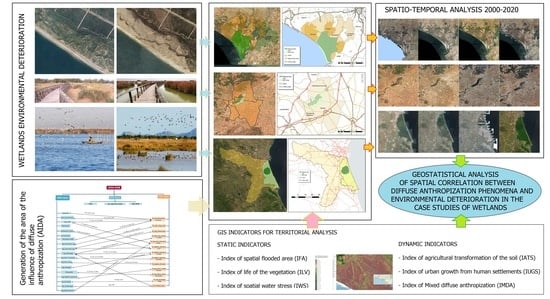Diffuse Anthropization Impacts in Vulnerable Protected Areas: Comparative Analysis of the Spatial Correlation between Land Transformation and Ecological Deterioration of Three Wetlands in Spain
Abstract
:1. Introduction
2. Environmental Issues: Areas of Study
2.1. National and Natural Park of Doñana
2.2. Tablas de Damiel National Park
2.3. The Albufera of Valencia Natural Park
3. Methodology
3.1. Spatial Selection of the Area of Influence of Diffuse Anthropization (AIDA) of the Parks
3.2. GIS Indicators for Territorial Analysis of Natural Protected Wetlands
3.2.1. Index of Spatial Flooded Area (IFA)
3.2.2. Index of Life of the Vegetation (ILV)
3.2.3. Index of Spatial Water Stress (IWS)
3.2.4. Index of Agricultural Transformation of the Soil (IATS)
3.2.5. Index of Urban Growth from Human Settlements (IUGS)
3.2.6. Index of Mixed Diffuse Anthropization (IMDA)
3.3. Geostatistical Evaluation Indicators
4. Results
4.1. Spatiotemporal Analysis of GIS Indicators
4.2. Autocorrelation Analysis
4.3. LISA and OLS Analysis
5. Discussion and Policy Implications
6. Conclusions
Supplementary Materials
Author Contributions
Funding
Institutional Review Board Statement
Informed Consent Statement
Conflicts of Interest
Appendix A
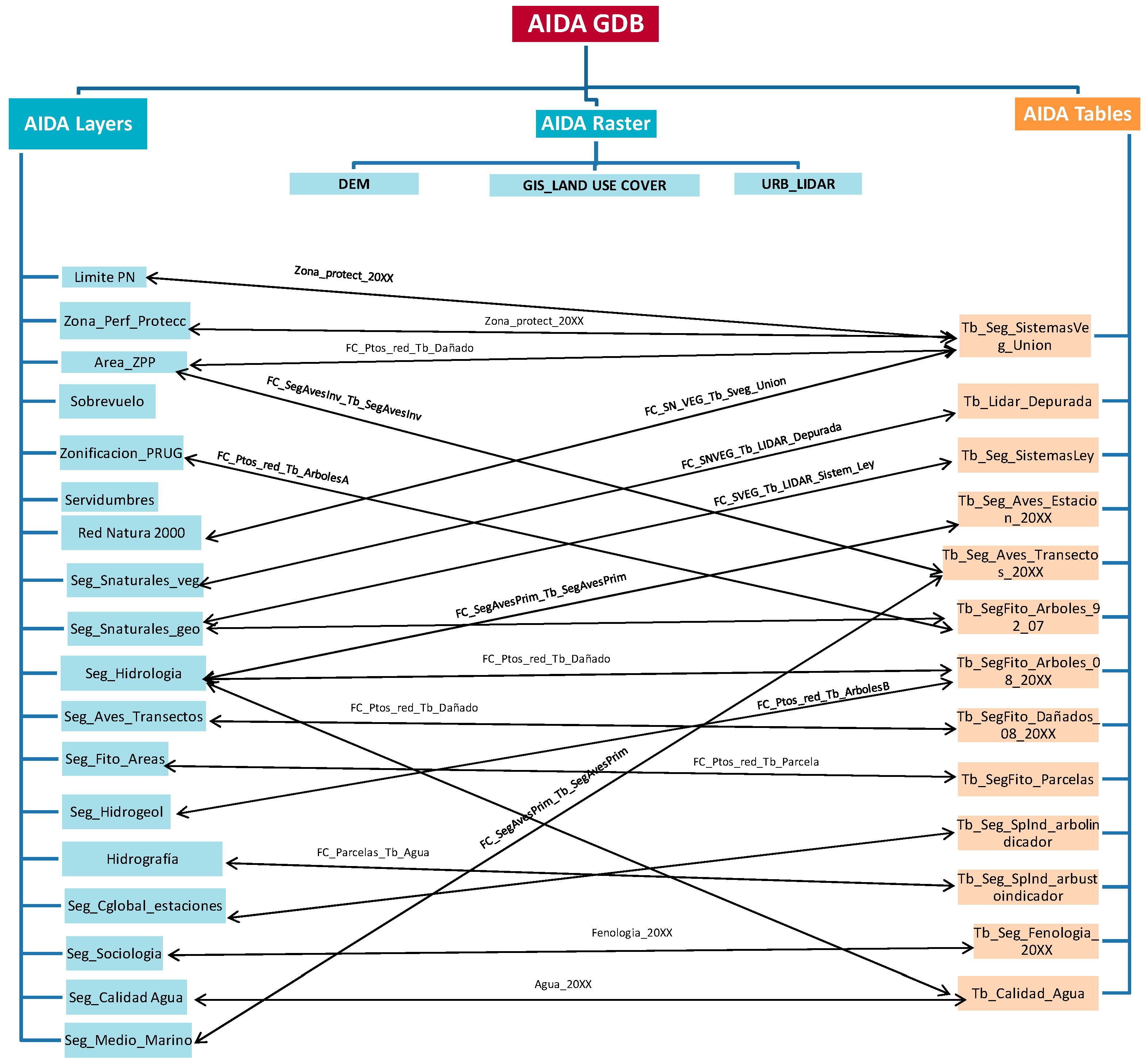
Appendix B
- -
- Agricultural transformation: categories 212, 213, 221, 222, 223, 231, 241, 242, 243 and 244.
- -
- Urbanized areas: categories 111, 112, 133 and 142.
- -
- Artificial soil transformation: agricultural transformation and urbanized areas categories plus the following ones 121,122, 123, 124, 131, 132, 141 and 211.
Appendix C
| Band | Sentinel 2 | Wavelength | LandSat 8 | Wavelength |
| 1 | Coastal spray | 0.443 | Coastal spray | 0.43 |
| 2 | Blue | 0.49 | Blue | 0.482 |
| 3 | Green | 0.56 | Green | 0.562 |
| 4 | Red | 0.665 | Red | 0.655 |
| 5 | Red edge | 0.705 | NIRS | 0.865 |
| 6 | Red edge | 0.74 | SWIR 1 | 1.61 |
| 7 | Red edge | 0.783 | SWIR 2 | 2.2 |
| 8 | NIRS | 0.842 | Panchromatic | 0.59 |
| 8A | Red edge | 0.865 | - | - |
| 9 | Water steam | 0.945 | Clouds | 1.375 |
| 10 | SWIR/Clouds | 1.375 | TIRS 1 (Thermal IR) | 10.9 |
| 11 | SWIR | 1.61 | TIRS 1 (Thermal IR) | 12 |
| 12 | SWIR | 2.19 | - | - |
| Band | LandSat 7 | Wavelength | LandSat 8 | Wavelength |
| 1 | Blue | 0.4775 | Blue | 0.4825 |
| 2 | Green | 0.56 | Green | 0.565 |
| 3 | Red | 0.6615 | Red | 0.66 |
| 4 | NIRS | 0.835 | NIRS | 0.8375 |
| 5 | SWIR 1 | 1.648 | SWIR 1 | 1.65 |
| 6 | TIR | 11.335 | TIR 1 | 11.45 |
| 7 | SWIR 2 | 2.2045 | TIR 2 | 2.22 |
| 8 | Panchromatic | 0.7055 | - | - |
| 8A | - | - | - | - |
| 9 | - | - | - | - |
| 10 | - | - | - | - |
| 11 | - | - | - | - |
| 12 | - | - | - | - |
Appendix D
References
- Zoppi, C. Integration of conservation measures concerning natura 2000 sites into marine protected areas regulations: A study related to Sardinia. Sustainability 2018, 10, 3460. [Google Scholar] [CrossRef]
- Bueno, P.F.; Schiavetti, A. The influence of fisherman scale in the resilience of socio-ecological systems: An analysis using Q methodology. Ocean Coast. Manag. 2019, 169, 214–224. [Google Scholar] [CrossRef]
- García-Ayllón, S. Diagnosis of complex coastal ecological systems: Environmental GIS analysis of a highly stressed Mediterranean lagoon through spatiotemporal indicators. Ecol. Indic. 2017, 83, 451–462. [Google Scholar] [CrossRef]
- Velasco, A.M.; Pérez-Ruzafa, A.; Martínez-Paz, J.M.; Marcos, C. Ecosystem services and main environmental risks in a coastal lagoon (Mar Menor, Murcia, SE Spain): The public perception. J. Nat. Conserv. 2018, 43, 180–189. [Google Scholar] [CrossRef]
- Waylen, K.A.; Blackstock, K.L.; Van Hulst, F.; Damian, C.; Horváth, F.; Johnson, R.K.; Kanka, R.; Külvik, M.; Macleod, C.J.; Meissner, K.; et al. Policy-driven monitoring and evaluation: Does it support adaptive management of socio-ecological systems? Sci. Total. Environ. 2019, 662, 373–384. [Google Scholar] [CrossRef]
- Garcia-Ayllon, S.; Miralles, J.L.; Bejan, A.; Brebbia, C.; Bryant, J.; Burgess, S.; Chon, T.; Jørgensen, S.; Patten, B.; Pasini, D.; et al. The environmental impacts of land transformation in the coastal perimeter of the Mar Menor Lagoon (Spain). Int. J. Des. Nat. Ecodynamics 2014, 9, 109–128. [Google Scholar] [CrossRef] [Green Version]
- Lin, Y.-P.; Hong, N.-M.; Wu, P.-J.; Wu, C.-F.; Verburg, P.H. Impacts of land use change scenarios on hydrology and land use patterns in the Wu-Tu watershed in Northern Taiwan. Landsc. Urban Plan. 2007, 80, 111–126. [Google Scholar] [CrossRef]
- Lins-De-Barros, F.M. Integrated coastal vulnerability assessment: A methodology for coastal cities management integrating socioeconomic, physical and environmental dimensions—Case study of Região dos Lagos, Rio de Janeiro, Brazil. Ocean Coast. Manag. 2017, 149, 1–11. [Google Scholar] [CrossRef]
- Kataržytė, M.; Mėžinė, J.; Vaičiūtė, D.; Liaugaudaitė, S.; Mukauskaitė, K.; Umgiesser, G.; Schernewski, G. Fecal contamination in shallow temperate estuarine lagoon: Source of the pollution and environmental factors. Mar. Pollut. Bull. 2018, 133, 762–772. [Google Scholar] [CrossRef]
- Yuan, F.; Wei, Y.D.; Gao, J.; Chen, W. Water crisis, environmental regulations and location dynamics of pollution-intensive industries in China: A study of the Taihu Lake watershed. J. Clean. Prod. 2019, 216, 311–322. [Google Scholar] [CrossRef]
- Hou, D.; O’Connor, D.; Nathanail, P.; Tian, L.; Ma, Y. Integrated GIS and multivariate statistical analysis for regional scale assessment of heavy metal soil contamination: A critical review. Environ. Pollut. 2017, 231, 1188–1200. [Google Scholar] [CrossRef]
- Rigollet, V.; Sfriso, A.; Marcomini, A.; De Casabianca, M. Seasonal evolution of heavy metal concentrations in the surface sediments of two Mediterranean Zostera marina L. beds at Thau lagoon (France) and Venice lagoon (Italy). Bioresour. Technol. 2004, 95, 159–167. [Google Scholar] [CrossRef]
- Maanan, M.; Saddik, M.; Maanan, M.; Chaibi, M.; Assobhei, O.; Zourarah, B. Environmental and ecological risk assessment of heavy metals in sediments of Nador lagoon, Morocco. Ecol. Indic. 2015, 48, 616–626. [Google Scholar] [CrossRef]
- Wei, L.; Luo, Y.; Wang, M.; Su, S.; Pi, J.; Li, G. Essential fragmentation metrics for agricultural policies: Linking landscape pattern, ecosystem service and land use management in urbanizing China. Agric. Syst. 2020, 182, 102833. [Google Scholar] [CrossRef]
- Muñoz-Reinoso, J.C. Vegetation changes and groundwater abstraction in SW Doñana, Spain. J. Hydrol. 2001, 242, 197–209. [Google Scholar] [CrossRef]
- Berzas, J.; García, L.; Rodríguez, R.; Martín-Alvarez, P. Evolution of the water quality of a managed natural wetland: Tablas de Daimiel National Park (Spain). Water Res. 2000, 34, 3161–3170. [Google Scholar] [CrossRef]
- Soria, J.; Vera-Herrera, L.; Calvo, S.; Romo, S.; Vicente, E.; Sahuquillo, M.; Sòria-Perpinyà, X. Residence time analysis in the albufera of Valencia, a Mediterranean Coastal Lagoon, Spain. Hydrology 2021, 8, 37. [Google Scholar] [CrossRef]
- García-Ayllón, S. GIS Assessment of mass tourism anthropization in sensitive coastal environments: Application to a case study in the Mar Menor Area. Sustainability 2018, 10, 1344. [Google Scholar] [CrossRef] [Green Version]
- Ju, Y.; Lindbergh, S.; He, Y.; Radke, J.D. Climate-related uncertainties in urban exposure to sea level rise and storm surge flooding: A multi-temporal and multi-scenario analysis. Cities 2019, 92, 230–246. [Google Scholar] [CrossRef]
- Boongaling, C.G.K.; Faustino-Eslava, D.V.; Lansigan, F.P. Modeling land use change impacts on hydrology and the use of landscape metrics as tools for watershed management: The case of an ungauged catchment in the Philippines. Land Use Policy 2018, 72, 116–128. [Google Scholar] [CrossRef]
- Daniele, L.; Vallejos, Á.; Corbella, M.; Molina, L.; Pulido-Bosch, A. Hydrogeochemistry and geochemical simulations to assess water-rock interactions in complex carbonate aquifers: The case of Aguadulce (SE Spain). Appl. Geochem. 2013, 29, 43–54. [Google Scholar] [CrossRef]
- Valdes-Abellan, J.; Pardo, M.; Jodar-Abellan, A.; Pla, C.; Fernandez-Mejuto, M. Climate change impact on karstic aquifer hydrodynamics in southern Europe semi-arid region using the KAGIS model. Sci. Total. Environ. 2020, 723, 138110. [Google Scholar] [CrossRef]
- Baudron, P.; Alonso-Sarría, F.; García-Aróstegui, J.-L.; Cánovas-García, F.; Martínez-Vicente, D.; Moreno-Brotóns, J. Identifying the origin of groundwater samples in a multi-layer aquifer system with Random Forest classification. J. Hydrol. 2013, 499, 303–315. [Google Scholar] [CrossRef]
- Falcone, J.A.; Carlisle, D.M.; Weber, L.C. Quantifying human disturbance in watersheds: Variable selection and performance of a GIS-based disturbance index for predicting the biological condition of perennial streams. Ecol. Indic. 2010, 10, 264–273. [Google Scholar] [CrossRef]
- García-Ayllón, S. Predictive diagnosis of agricultural periurban areas based on territorial indicators: Comparative landscape trends of the so-called “Orchard of Europe”. Sustainaility 2018, 10, 1820. [Google Scholar] [CrossRef] [Green Version]
- Mancilla-Leytón, J.; Fernández-Alés, R.; Vicente, Á.M. Effects of diet selection by goats grazing on the vegetation of a protected pine forest in Doñana Natural Park (SW Spain). Sustainability 2021, 13, 3950. [Google Scholar] [CrossRef]
- Bustamante, J.; Pacios, F.; Díaz-Delgado, R.; Aragonés, D. Predictive models of turbidity and water depth in the Doñana marshes using Landsat TM and ETM+ images. J. Environ. Manag. 2009, 90, 2219–2225. [Google Scholar] [CrossRef] [PubMed]
- Márquez-Ferrando, R.; Figuerola, J.; Hooijmeijer, J.C.; Piersma, T. Recently created man-made habitats in Doñana provide alternative wintering space for the threatened Continental European black-tailed godwit population. Biol. Conserv. 2014, 171, 127–135. [Google Scholar] [CrossRef] [Green Version]
- Adame, J.; Lope, L.; Hidalgo, P.; Sorribas, M.; Gutiérrez-Álvarez, I.; Del Águila, A.; Saiz-Lopez, A.; Yela, M. Study of the exceptional meteorological conditions, trace gases and particulate matter measured during the 2017 forest fire in Doñana Natural Park, Spain. Sci. Total. Environ. 2018, 645, 710–720. [Google Scholar] [CrossRef]
- Fernandez-Carrillo, A.; Sanchez-Rodriguez, E.; Rodriguez-Galiano, V. Characterising marshland temporal dynamics using remote sensing: The case of Bolboschoenetum maritimi in Doñana national park. Appl. Geogr. 2019, 112, 102094. [Google Scholar] [CrossRef]
- Ruiz, F.; Pozo, M.; Carretero, M.I.; Muñoz, J.M.; González-Regalado, M.L.; Abad, M.; Izquierdo, T.; Vidal, J.R.; Cáceres, L.M.; Monge, G. Whole-rock and clay mineralogy as paleoenvironmental tracers during the Late Holocene sedimentary evolution of the Doñana National Park (SW Spain). Appl. Clay Sci. 2020, 197, 105780. [Google Scholar] [CrossRef]
- De la Hera, Á.; Villarroya, F. Services evolution of two groundwater dependent wetland ecosystems in the “Mancha Húmeda” Biosphere Reserve (Spain). Resources 2013, 2, 128–150. [Google Scholar] [CrossRef] [Green Version]
- Cirujano, S.; Casado, C.; Bernués, M.; Camargo, J. Ecological study of Las Tablas de Daimiel National Park (Ciudad Real, Central Spain): Differences in water physico-chemistry and vegetation between 1974 and 1989. Biol. Conserv. 1996, 75, 211–215. [Google Scholar] [CrossRef]
- Valiño, M.D.; Rodríguez, A.V.; Zapata, M.B.R.; Gil García, M.J.; Gutiérrez, I.D.B. Climatic changes since the late-glacial/holocene transition in La Mancha Plain (South-central Iberian Peninsula, Spain) and their incidence on Las Tablas de Daimiel marshlands. Quat. Int. 2002, 93-94, 73–84. [Google Scholar] [CrossRef]
- Rey, J.; Martínez, J.; Mediavilla, R.; Santisteban, J.I.; Castaño, S.C.; De la Losa, A. Geophysical characterization of stratigraphical surfaces: Basin floor and sedimentological architectural elements of Las Tablas de Daimiel (Quaternary of Southern-Central Spain). J. Appl. Geophys. 2017, 136, 387–399. [Google Scholar] [CrossRef]
- Fernández-Trujillo, S.; López-Perea, J.J.; Jiménez-Moreno, M.; Martín-Doimeadios, R.C.R.; Mateo, R. Metals and metalloids in freshwater fish from the floodplain of Tablas de Daimiel National Park, Spain. Ecotoxicol. Environ. Saf. 2021, 208, 111602. [Google Scholar] [CrossRef] [PubMed]
- Sebastiá-Frasquet, M.-T.; Aguilar-Maldonado, J.A.; Santamaría-Del-Ángel, E.; Estornell, J. Sentinel 2 analysis of turbidity patterns in a Coastal Lagoon. Remote. Sens. 2019, 11, 2926. [Google Scholar] [CrossRef] [Green Version]
- Gargiulo, M.; Dell’Aglio, D.A.G.; Iodice, A.; Riccio, D.; Ruello, G. Integration of sentinel-1 and sentinel-2 data for land cover mapping using W-net. Sensors 2020, 20, 2969. [Google Scholar] [CrossRef] [PubMed]
- Dona, C.; Chang, N.-B.; Caselles, V.; Sánchez, J.M.; Camacho, A.; Delegido, J.; Vannah, B.W. Integrated satellite data fusion and mining for monitoring lake water quality status of the Albufera de Valencia in Spain. J. Environ. Manag. 2015, 151, 416–426. [Google Scholar] [CrossRef] [Green Version]
- Fernández, P.D.B.; Gómez, A.G.; Alba, J.G.; Díaz, C.Á.; Cortezón, J.A.R. A model for describing the eutrophication in a heavily regulated coastal lagoon. Application to the Albufera of Valencia (Spain). J. Environ. Manag. 2012, 112, 340–352. [Google Scholar] [CrossRef]
- Perilla, O.L.U.; Gómez, A.G.; Gómez, A.G.; Díaz, C.Á.; Cortezón, J.A.R. Methodology to assess sustainable management of water resources in Coastal Lagoons with agricultural uses: An application to the Albufera Lagoon of Valencia (Eastern Spain). Ecol. Indic. 2012, 13, 129–143. [Google Scholar] [CrossRef]
- Martín, M.; Hernández-Crespo, C.; Andrés-Doménech, I.; Benedito-Durá, V. Fifty years of eutrophication in the Albufera Lake (Valencia, Spain): Causes, evolution and remediation strategies. Ecol. Eng. 2020, 155, 105932. [Google Scholar] [CrossRef]
- Calvo, S.; Romo, S.; Soria, J.; Picó, Y. Pesticide contamination in water and sediment of the aquatic systems of the Natural Park of the Albufera of Valencia (Spain) during the rice cultivation period. Sci. Total. Environ. 2021, 774, 145009. [Google Scholar] [CrossRef]
- Wu, X.; Dong, W.; Lin, X.; Liang, Y.; Meng, Y.; Xie, W. Evolution of wetland in Honghe National Nature Reserve from the view of hydrogeology. Sci. Total. Environ. 2017, 609, 1370–1380. [Google Scholar] [CrossRef] [PubMed]
- Ahmed, K.R.; Akter, S.; Marandi, A.; Schüth, C. A simple and robust wetland classification approach by using optical indices, unsupervised and supervised machine learning algorithms. Remote. Sens. Appl. Soc. Environ. 2021, 23, 100569. [Google Scholar] [CrossRef]
- Garcia-Ayllon, S.; Radke, J. Geostatistical analysis of the spatial correlation between territorial anthropization and flooding vulnerability: Application to the DANA phenomenon in a Mediterranean watershed. Appl. Sci. 2021, 11, 809. [Google Scholar] [CrossRef]
- Guaita-García, N.; Martínez-Fernández, J.; Barrera-Causil, C.J.; Esteve-Selma, M.A.; Fitz, H.C. Local perceptions regarding a social–ecological system of the mediterranean coast: The Mar Menor (Región de Murcia, Spain). Environ. Dev. Sustain. 2021, 23, 2882–2909. [Google Scholar] [CrossRef]
- García-Ayllón, S. New strategies to improve co-management in enclosed Coastal Seas and Wetlands subjected to complex environments: Socio-economic analysis applied to an international recovery success case study after an environmental crisis. Sustainability 2019, 11, 1039. [Google Scholar] [CrossRef] [Green Version]
- Kantamaneni, K.; Phillips, M.; Thomas, T.; Jenkins, R. Assessing coastal vulnerability: Development of a combined physical and economic index. Ocean Coast. Manag. 2018, 158, 164–175. [Google Scholar] [CrossRef]
- Bianco, F.; Conti, P.; García-Ayllon, S.; Pranzini, E. An integrated approach to analyze sedimentary stock and coastal erosion in Vulnerable areas: Resilience assessment of San Vicenzo’s Coast (Italy). Water 2020, 12, 805. [Google Scholar] [CrossRef] [Green Version]
- García, N.G.; Fernández, J.M.; Fitz, C. Environmental scenario analysis on natural and social-ecological systems: A review of methods, approaches and applications. Sustainability 2020, 12, 7542. [Google Scholar] [CrossRef]
- Martín-López, B.; García-Llorente, M.; Palomo, I.; Montes, C. The conservation against development paradigm in protected areas: Valuation of ecosystem services in the Doñana social-ecological system (Southwestern Spain). Ecol. Econ. 2011, 70, 1481–1491. [Google Scholar] [CrossRef]
- Gao, B.-C. NDWI—A normalized difference water index for remote sensing of vegetation liquid water from space. Remote. Sens. Environ. 1996, 58, 257–266. [Google Scholar] [CrossRef]
- Sellers, P.J. Canopy reflectance, photosynthesis and transpiration. Int. J. Remote. Sens. 1985, 6, 1335–1372. [Google Scholar] [CrossRef]
- Agnoletti, M. The degradation of traditional landscape in a mountain area of Tuscany during the 19th and 20th centuries: Implications for biodiversity and sustainable management. For. Ecol. Manag. 2007, 249, 5–17. [Google Scholar] [CrossRef]
- García-Meléndez, E.; Molina, I.; Ferre-Julià, M.; Aguirre, J. Multisensor data integration and GIS analysis for Natural Hazard mapping in a semiarid area (Southeast Spain). Adv. Space Res. 1998, 21, 493–499. [Google Scholar] [CrossRef]
- Wu, C. Handbook of applied spatial analysis: Software tools, methods and applications. J. Reg. Sci. 2012, 52, 386–388. [Google Scholar] [CrossRef]
- Anselin, L. Local indicators of spatial association-LISA. Geogr. Anal. 1995, 27, 93–115. [Google Scholar] [CrossRef]
- Gómez, N.; Siri, A.; Capítulo, L.R.; Colautti, D.C.; Alcalde, L.; Capítulo, A.R.; Donato, M.; Álvarez, M.F.; de Souza, J.R.G.; Jensen, R.F.; et al. Effects of urban demand for food and water on physicochemicals and biotic structure of riverine wetlands in the Pampean plain. Ecohydrol. Hydrobiol. 2021, (in press). [Google Scholar] [CrossRef]
- Da Silva, F.L.; Stefani, M.S.; Smith, W.; Schiavone, D.C.; da Cunha-Santino, M.B.; Bianchini, I., Jr. An applied ecological approach for the assessment of anthropogenic disturbances in urban wetlands and the contributor river. Ecol. Complex. 2020, 43, 100852. [Google Scholar] [CrossRef]
- Li, D.; Tian, P.; Luo, Y.; Dong, B.; Cui, Y.; Khan, S. Importance of stopping groundwater irrigation for balancing agriculture and wetland ecosystem. Ecol. Indic. 2021, 127, 107747. [Google Scholar] [CrossRef]
- Sousa, C.A.; Cunha, M.E.; Ribeiro, L. Tracking 130 years of coastal wetland reclamation in Ria Formosa, Portugal: Opportunities for conservation and aquaculture. Land Use Policy 2020, 94, 104544. [Google Scholar] [CrossRef]
- McHarg, I.L. Design with Nature; Natural History Press: Cheltenham, UK, 1969. [Google Scholar]
- Steinitz, C. Simulating alternative policies for implementing the Massachusetts scenic and recreational rivers act: The North River demonstration project. Landsc. Plan. 1979, 6, 51–89. [Google Scholar] [CrossRef]
- Radke, J. Detecting potential erosion threats to the coastal zone: St. John, Usvi. Mar. Geodesy 1997, 20, 235–254. [Google Scholar] [CrossRef]
- Newton, A.; Weichselgartner, J. Hotspots of coastal vulnerability: A DPSIR analysis to find societal pathways and responses. Estuar. Coast. Shelf Sci. 2014, 140, 123–133. [Google Scholar] [CrossRef]
- Everard, M. A socio-ecological framework supporting catchment-scale water resource stewardship. Environ. Sci. Policy 2019, 91, 50–59. [Google Scholar] [CrossRef]
- Berrouet, L.; Machado, J.; Villegas-Palacio, C. Vulnerability of socio—ecological systems: A conceptual framework. Ecol. Indic. 2018, 84, 632–647. [Google Scholar] [CrossRef]
- Hein, M.Y.; Birtles, A.; Willis, B.L.; Gardiner, N.; Beeden, R.; Marshall, N.A. Coral restoration: Socio-ecological perspectives of benefits and limitations. Biol. Conserv. 2019, 229, 14–25. [Google Scholar] [CrossRef]
- Allpass, J. Static versus dynamic planning: A complimentary approach. Ekistics 1967, 24, 489–491. [Google Scholar]
- Fernández, B.G.; Gámir, V.N.; Sánchez, L.A. A synthetic model of surface inundation relationships and water source impacts of the wetland Las Tablas de Daimiel National Park, Central Spain. Ecol. Eng. 2013, 61, 407–418. [Google Scholar] [CrossRef]
- García-Ayllón, S. Integrated management in coastal lagoons of highly complexity environments: Resilience comparative analysis for three case-studies. Ocean Coast. Manag. 2017, 143, 16–25. [Google Scholar] [CrossRef]
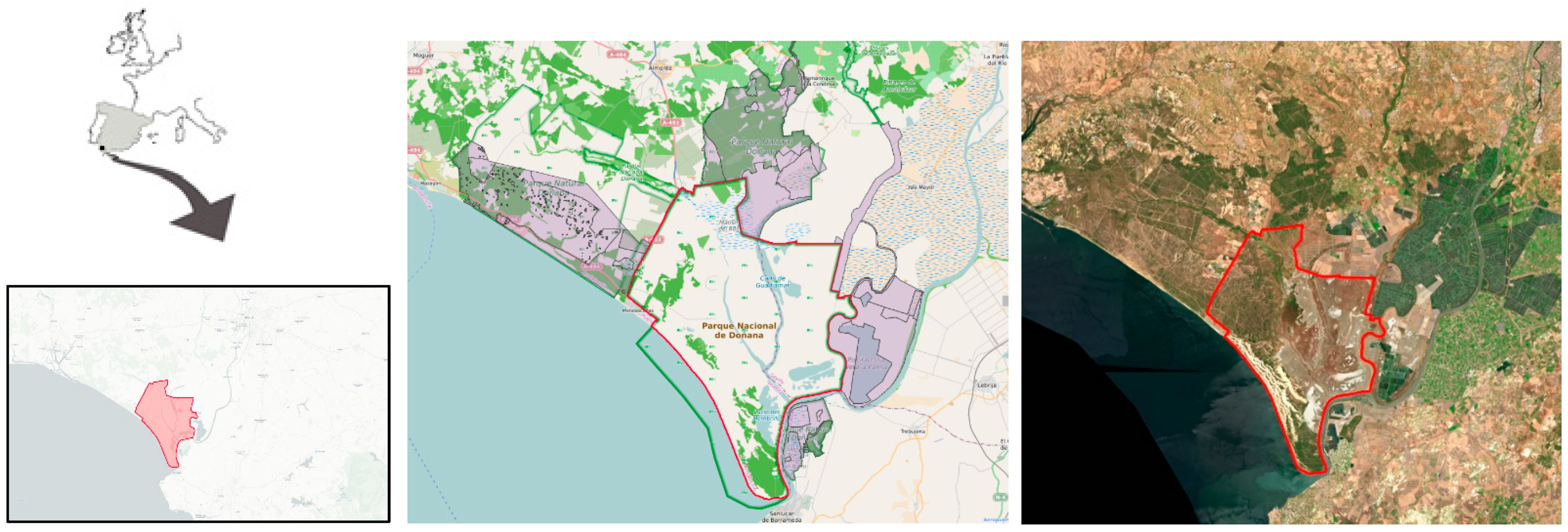
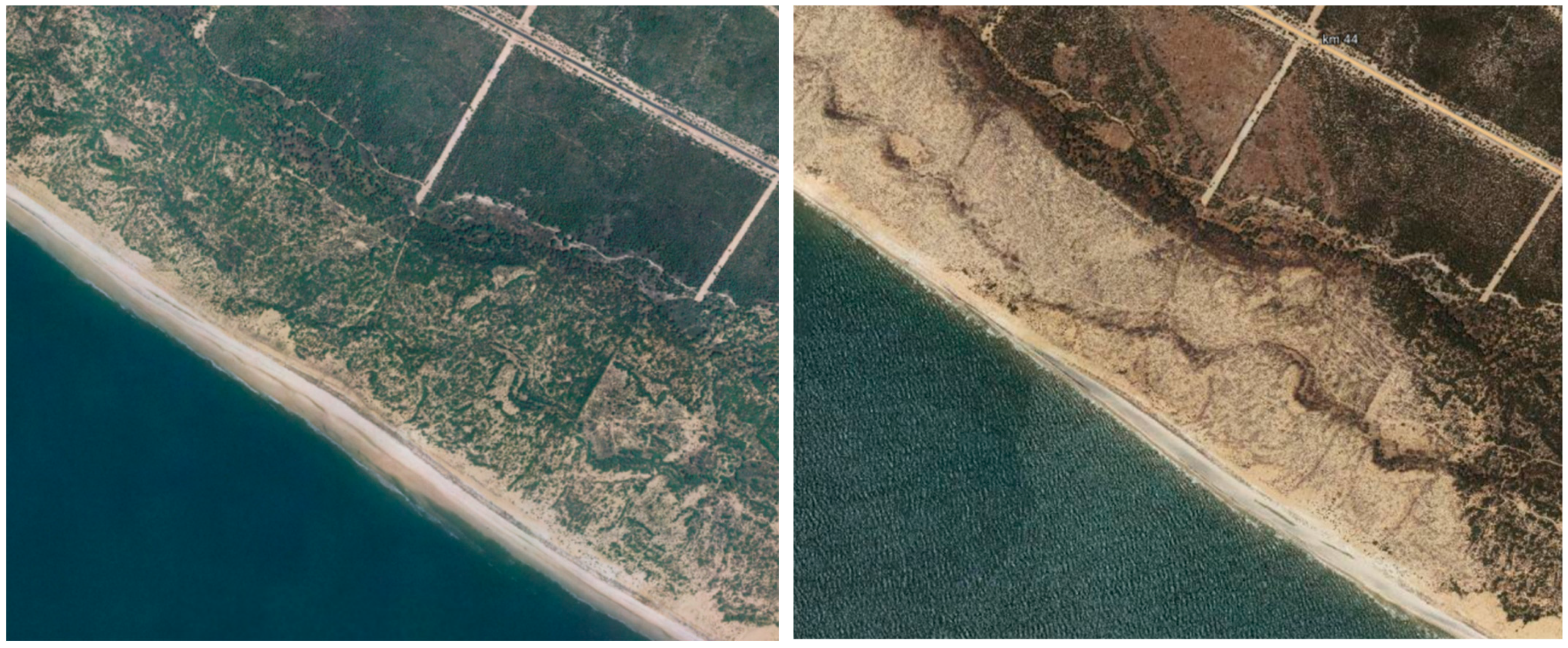

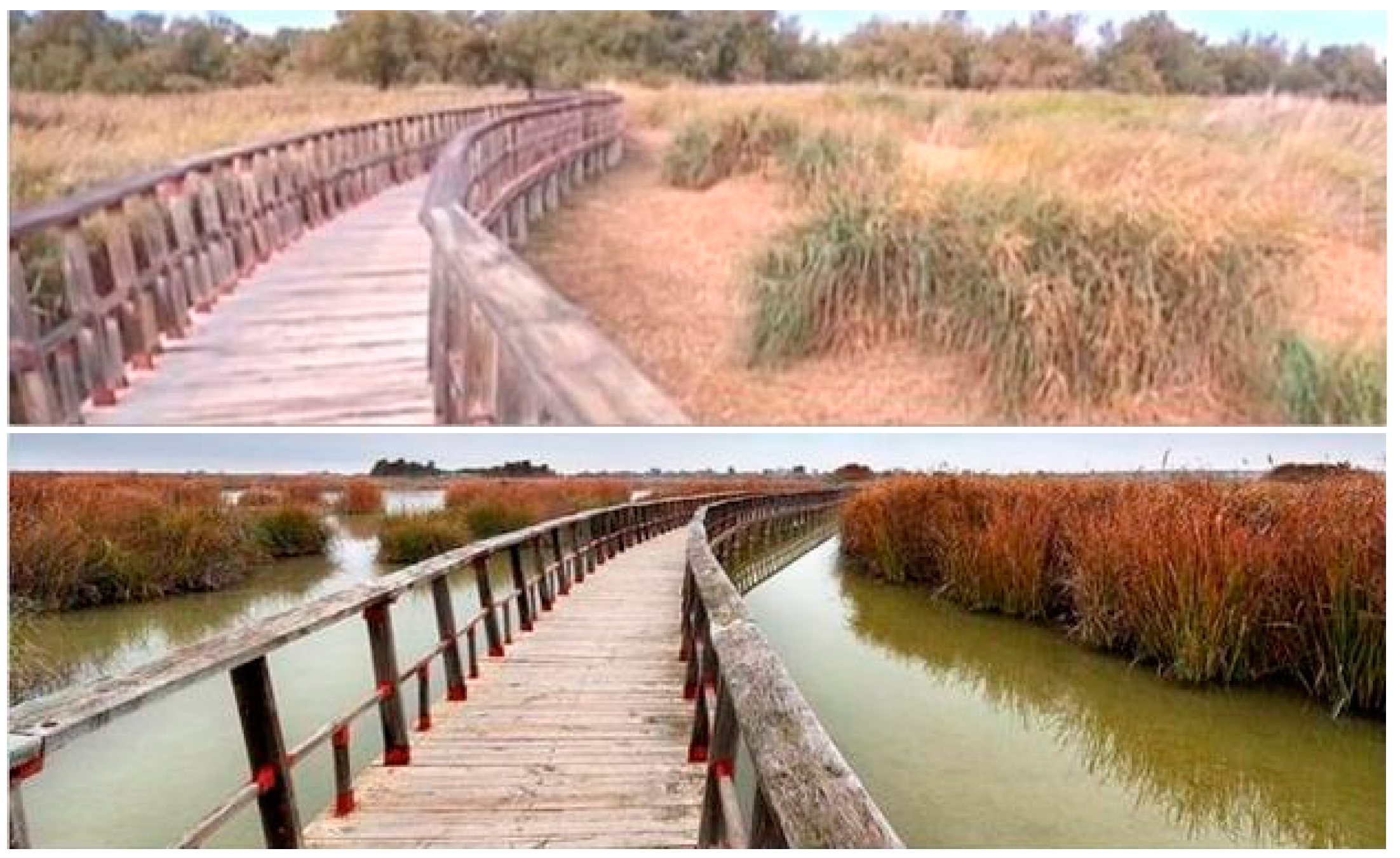
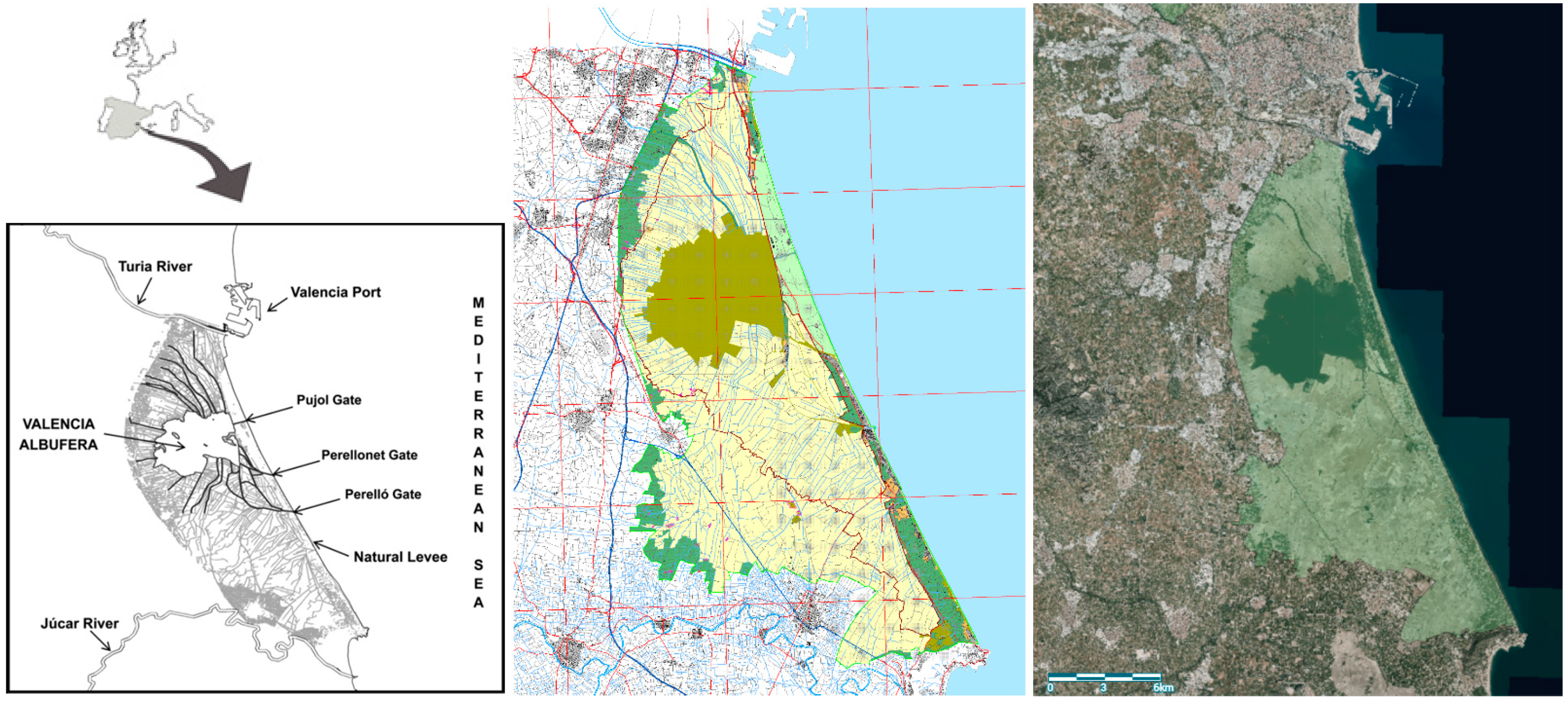
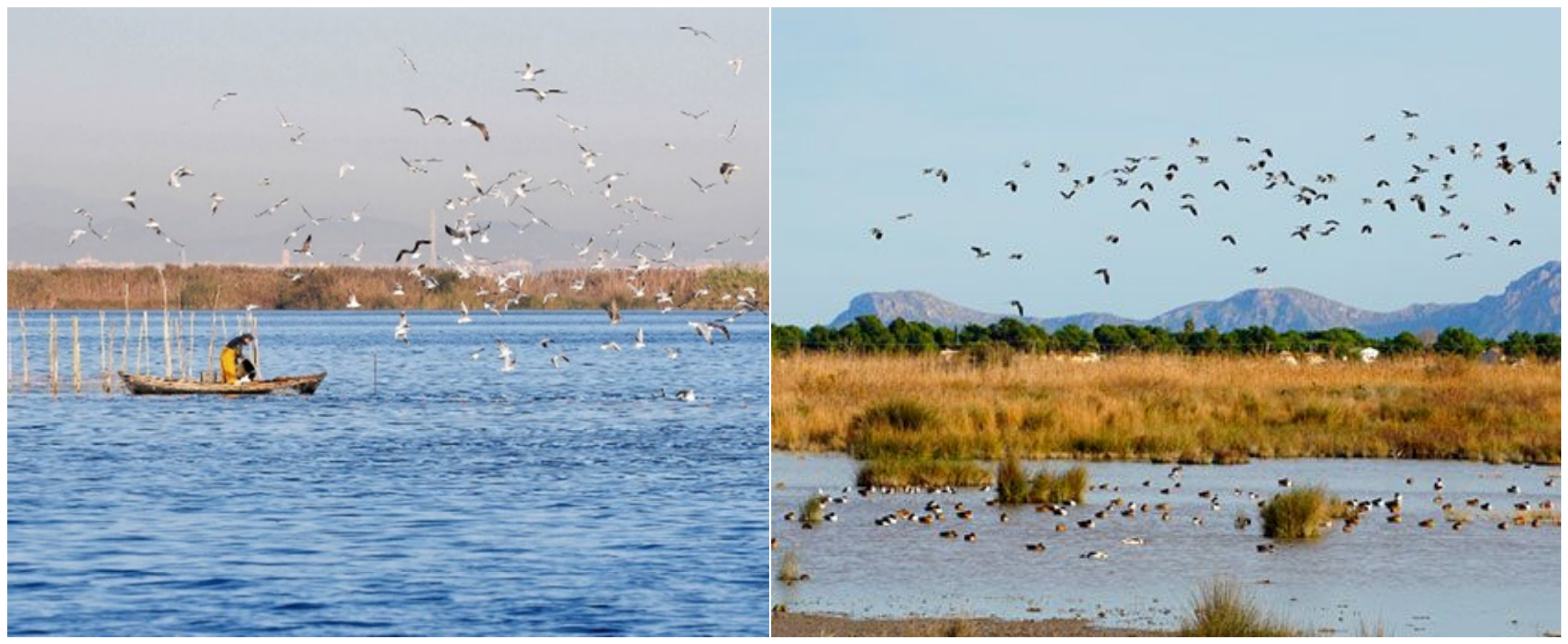
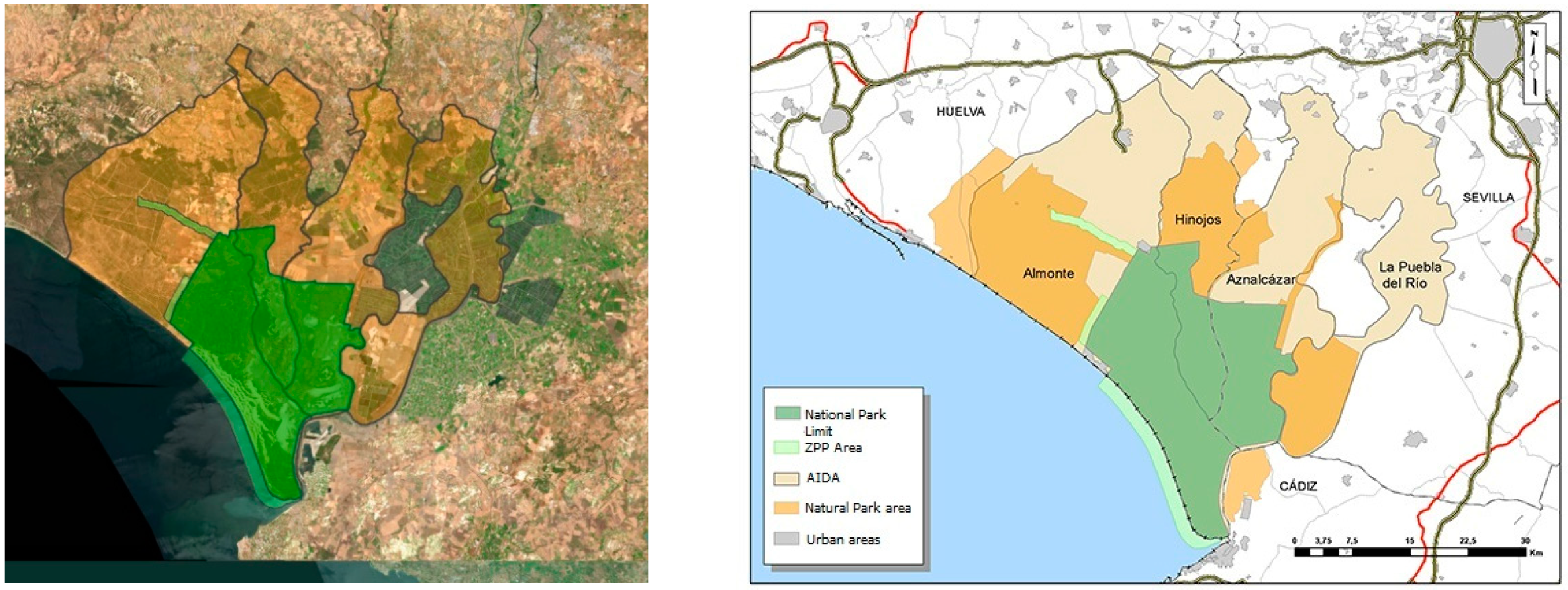
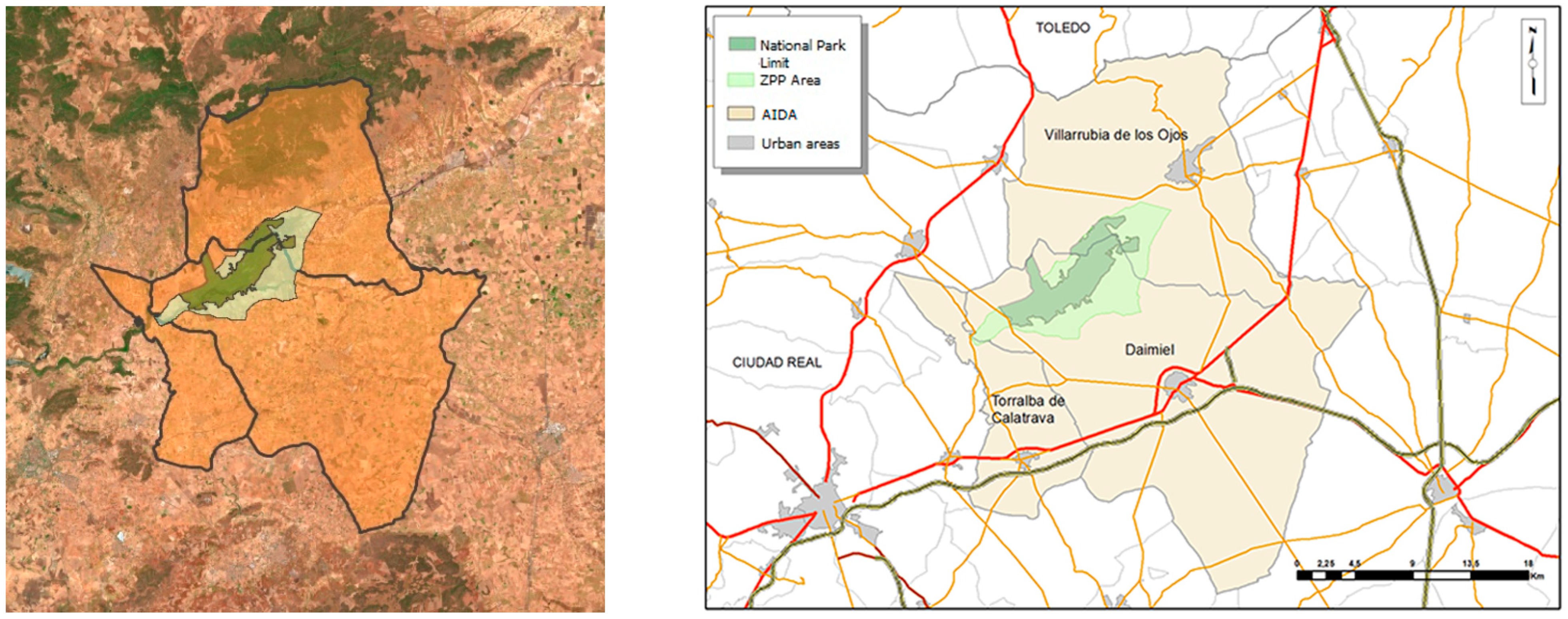
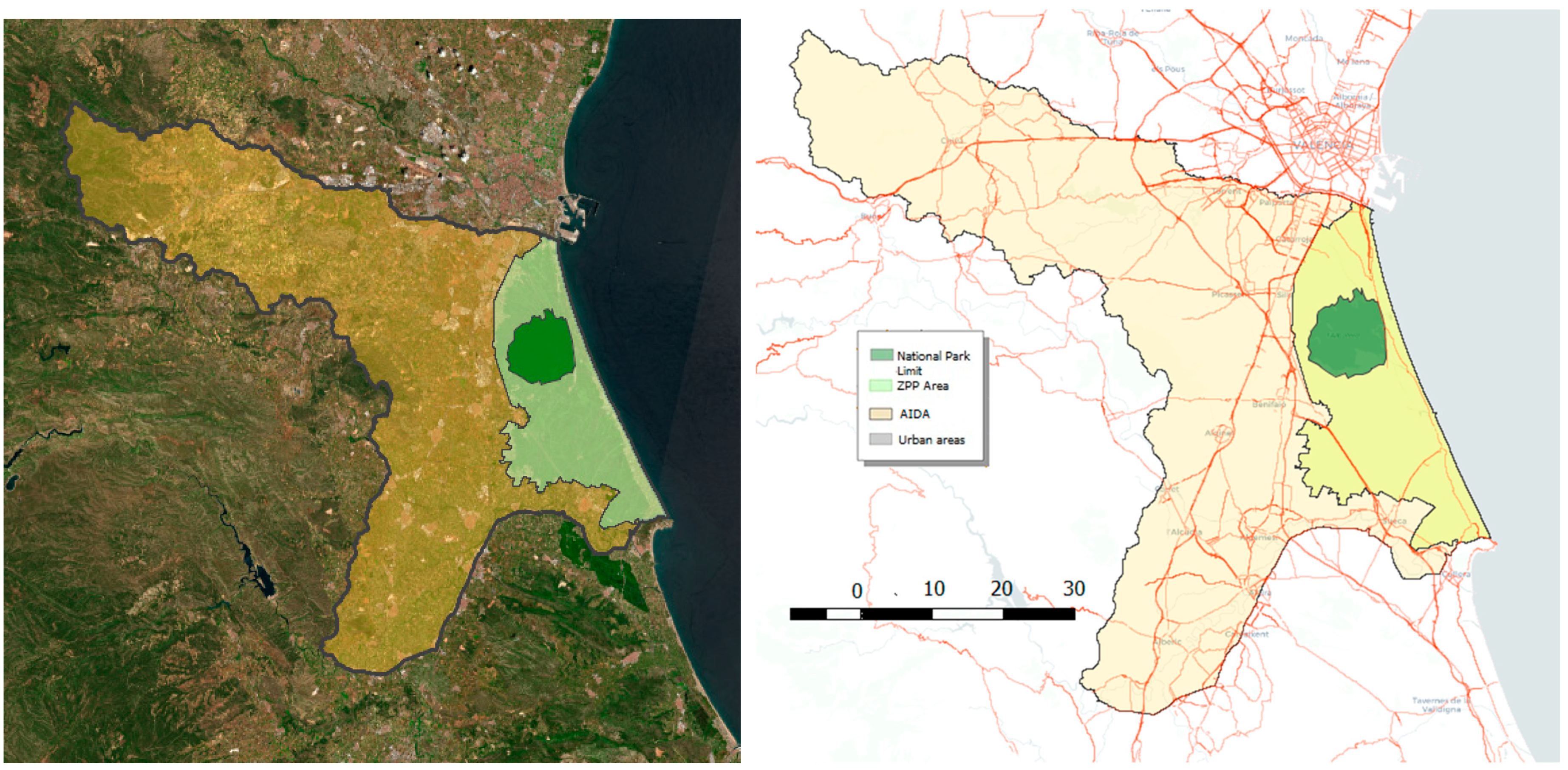
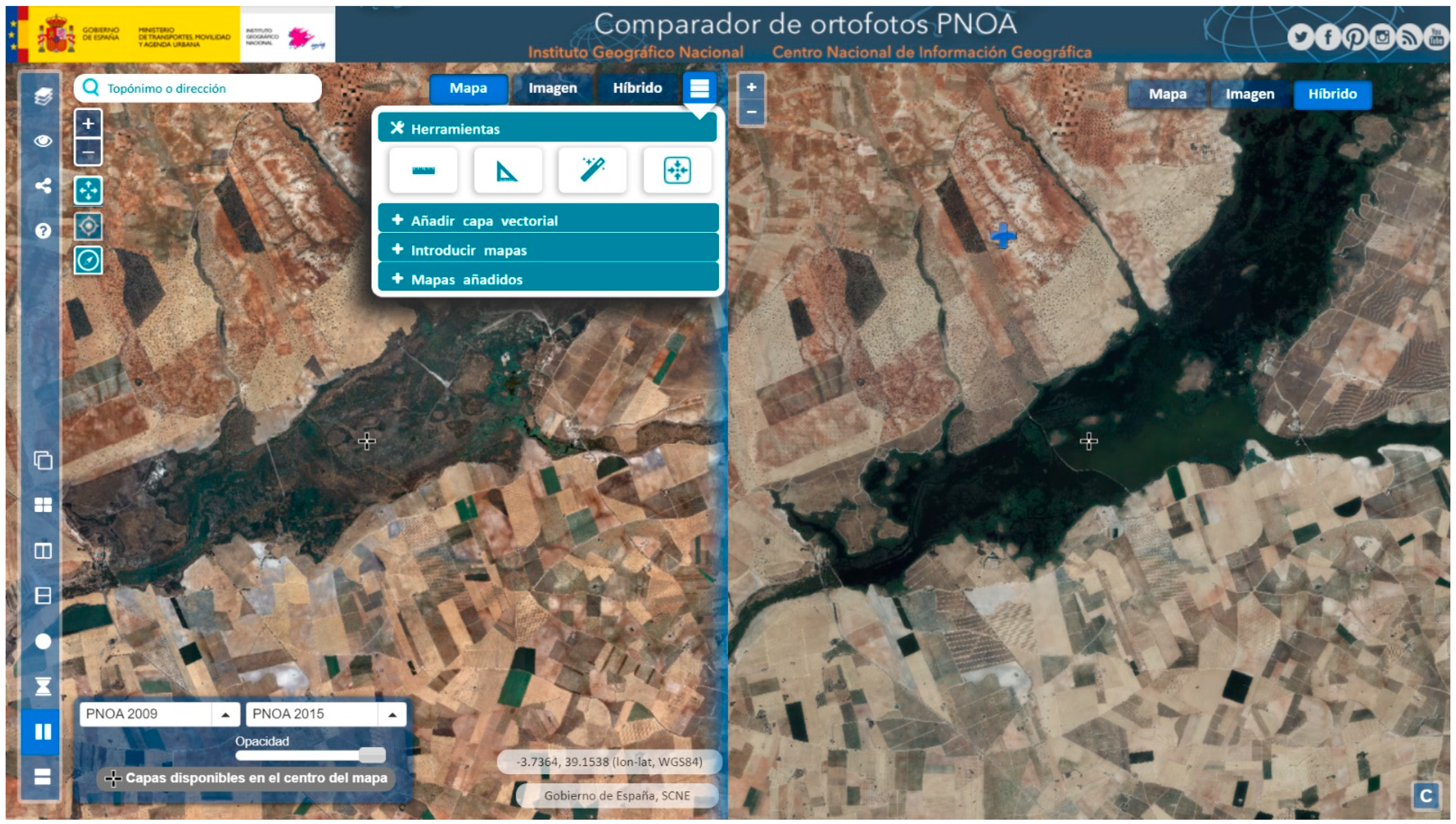
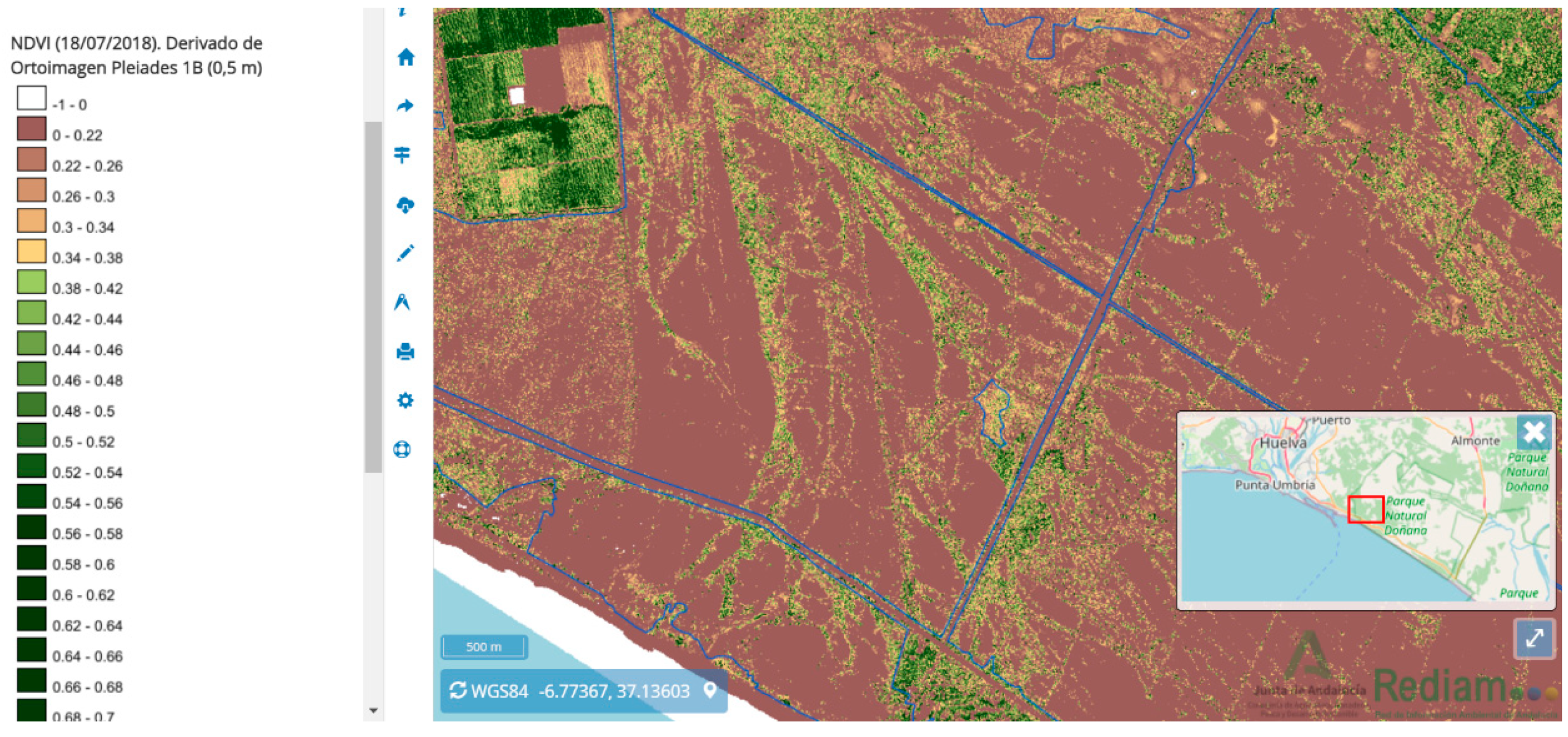




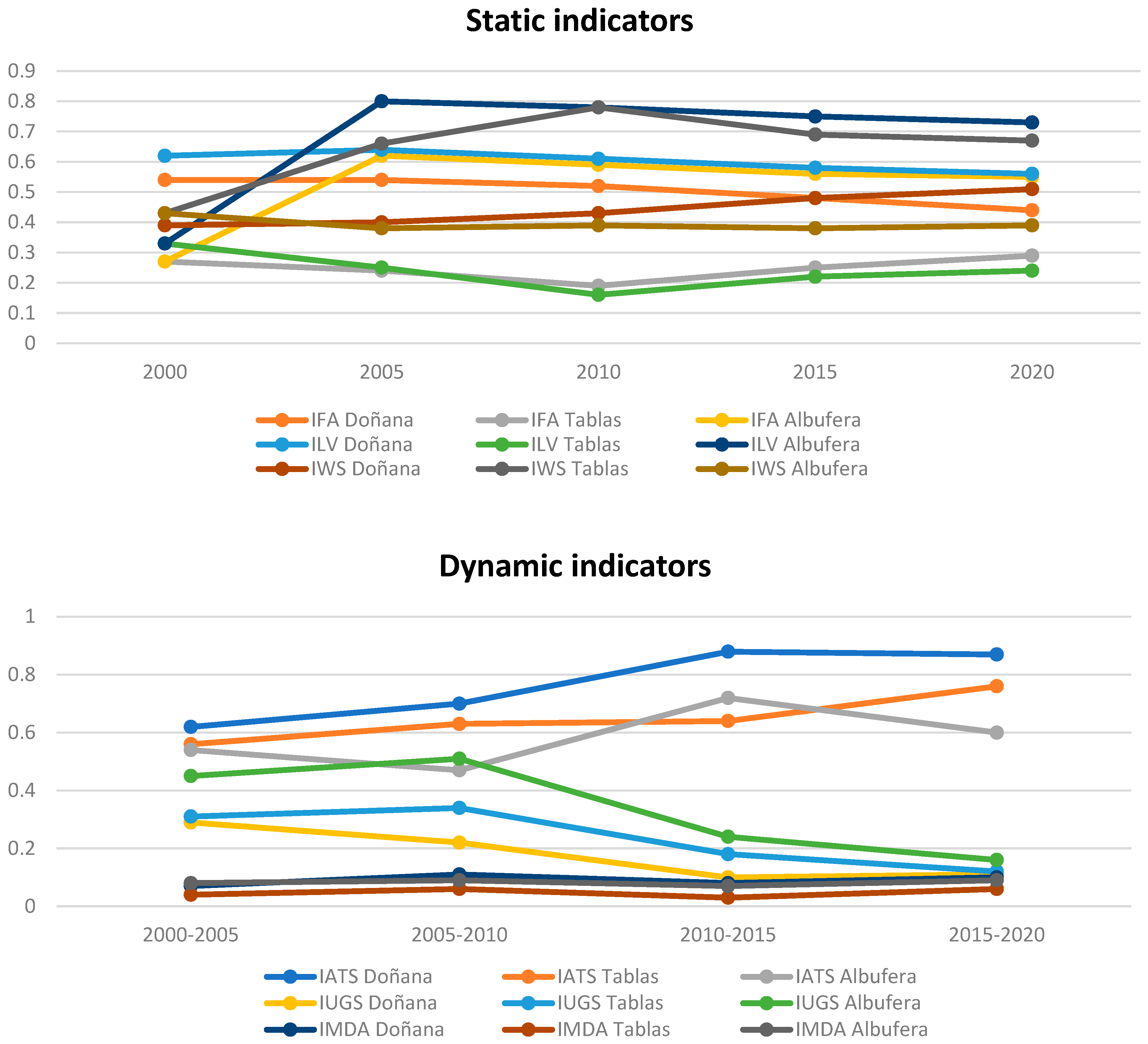
| Criteria | General Parameters | Specific Criteria Applied | GIS Analysis Example |
|---|---|---|---|
| Underground hydrogeology | The maximum area of influence is established as the surface area covered by the aquifer that feeds the protected natural space with water. In the case of very large aquifers, this area of influence can be reduced to the surface percentage that establishes a permanent flow of water in the natural space during all seasons of the year [44]. | [15,21,22] |  |
| Surface hydrology | The maximum area of influence is established as the area covered by the surface drainage hydrographic sub-basin that encompasses or empties into the protected natural area. Only channels with Horton indices greater than 2 will be computed for the surface area of the basin. In the case of very large basins, this area of impact can be reduced by computing only Horton indices greater than or equal to 4 [45]. | [17,34,42] |  |
| Land use planning | The structure of the territory must be considered both at the level of uses and the terrain orography. All those uses included in Corine Land Cover categories that generate direct or indirect anthropogenic impacts on protected areas may be included [46]. | [35,38,42] | 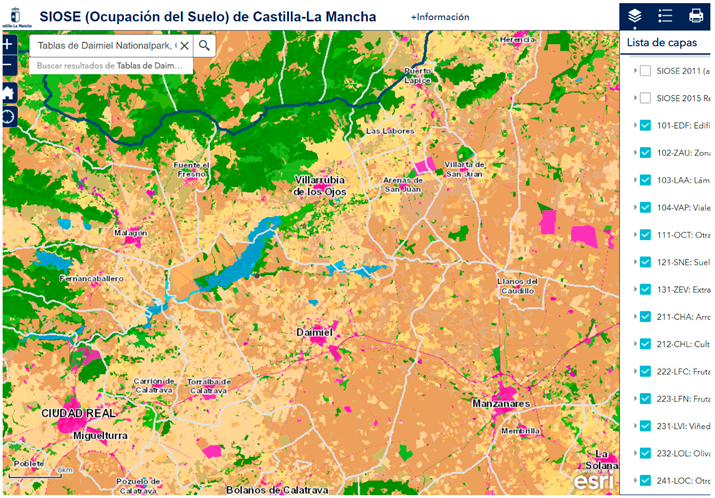 |
| Sociology | The administrative structure of territory and the mobility patterns of people in the areas adjacent to the protected area must be taken into account. The presence of relevant transport infrastructures such as motorways and urban settlements, especially those of a tourist nature, are considered [47]. | [48,49] | 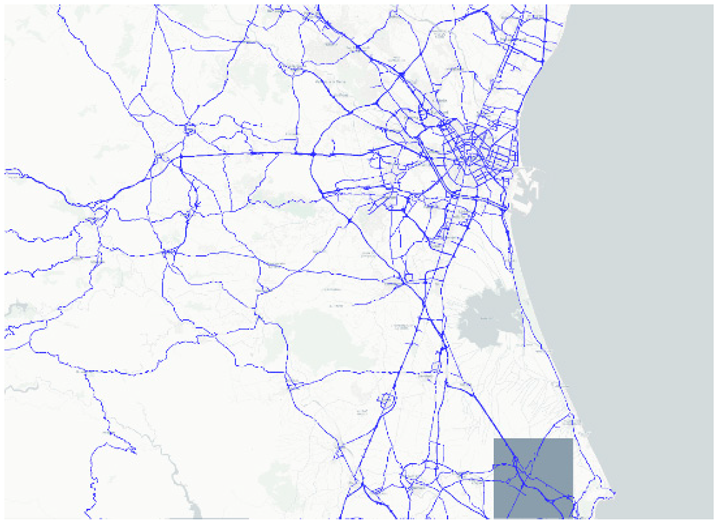 |
| Sedimentary dynamics | In estuarine seaside protected areas and coastal lagoons formed from dune ridges or mangroves, coastal infrastructures such as ports or breakwaters and other anthropogenic elements that generate impacts on the sedimentary dynamics of the wetlands are considered [50]. | [38,39,42] | 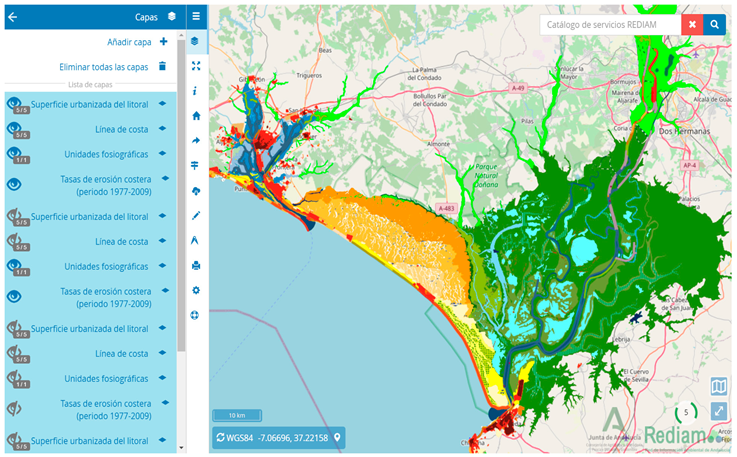 |
| Environmental planning of ecosystems | The existing protection tools beyond those legally established by the protected area must be taken into account, including those other environmental management instruments that have some link to the behavior of the species (ecological corridors, management plans for adjacent spaces, etc.) [51]. | [16,27,52] |  |
| Mapping Data | Pixel Size Projected on the GSD Ground (cm) | Planimetric Accuracy (X,Y) Mean Squared Error (m) | Altimetric Accuracy (Z) Mean Squared Error (m) | Mesh Step | |
|---|---|---|---|---|---|
| Flight | Orthophoto | ||||
| 2000–2004 | 45 | 50 | <1.00 | <2.00 | 5 × 5 |
| 2005–2020 | 22 | 25 | <0.50 | <1.00 | 5 × 5 |
| Static indicators | IFA | ILV | IWS |
| Global Moran’s Index | 0.33/0.41/0.71 | 0.37/0.52/0.49 | 0.38/0.41/0.12 |
| z-score | 29.3/35.1/62.5 | 30.0/44.8/42.4 | 34.7/22.3/13.5 |
| p-value | 0.01/0.01/0.01 | 0.01/0.01/0.01 | 0.01/0.01/0.01 |
| Dynamic indicators | IATS | IUGS | IMDA |
| Global Moran’s Index | 0.46/0.31/0.65 | 0.66/0.71/0.70 | 0.11/0.14/0.16 |
| z-score | 50.4/22.8/53.9 | 58.5/59.3/52.2 | 15.7/13.3/20.6 |
| p-value | 0.01/0.01/0.01 | 0.01/0.01/0.01 | 0.01/0.01/0.01 |
| Doñana National Park. | ||||||||
| GIS Indicators | Flooded Area (IFA) | Life of Vegetation (ILV) | ||||||
| B | Std. Error | t | Sign. | B | Std. Error | t | Sign. | |
| 0.185 | 0.003 | 4.112 | 0.000 * | −0.446 | 0.003 | −2.034 | 0.000 * | |
| 0.107 | 0.005 | 2.248 | 0.000 * | −0.315 | 0.009 | 0.932 | 0.000 * | |
| 0.132 | 0.008 | 3.710 | 0.000 * | −0.279 | 0.010 | −4.183 | 0.000 * | |
| Akaike’s information criterion (AIC): 22,765.5 | AIC: 23,508.1 | |||||||
| Multiple R-squared: 0.19 | Multiple R-squared: 0.22 | |||||||
| Adjusted R-squared: 0.18 | Adjusted R-squared: 0.22 | |||||||
| F-statistic: 139.24 Prob (>F) (3,3) degrees of freedom: 0 | F-statistic: 155.81 Prob (>F) (3,3) DF: 0 | |||||||
| GIS indicators | Water stress (IWS) | |||||||
| B | Std. error | T | Sign. | |||||
| 0.327 | 0.004 | 2.102 | 0.000 * | |||||
| 0.292 | 0.010 | 1.434 | 0.000 * | |||||
| 0.273 | 0.012 | 1.811 | 0.000 * | |||||
| Akaike’s information criterion (AIC): 22,061.2 | ||||||||
| Multiple R-squared: 0.24 | ||||||||
| Adjusted R-squared: 0.23 | ||||||||
| F-statistic: 150.62 Prob (>F) (3,3) degrees of freedom: 0 | ||||||||
| * Significant at 0.01 level. | ||||||||
| Tablas de Daimiel National Park | ||||||||
| GIS indicators | Flooded area (IFA) | Life of vegetation (ILV) | ||||||
| B | Std. Error | t | Sign. | B | Std. Error | t | Sign. | |
| 0.166 | 0.007 | 2.623 | 0.000 * | −0.436 | 0.013 | 0.227 | 0.000 * | |
| 0.107 | 0.005 | 6.243 | 0.000 * | −0.315 | 0.009 | −2.924 | 0.000 * | |
| 0.122 | 0.006 | 4.714 | 0.000 * | −0.179 | 0.006 | −5.132 | 0.000 * | |
| Akaike’s information criterion (AIC): 23,116.7 | AIC: 23,173.2 | |||||||
| Multiple R-squared: 0.43 | Multiple R-squared: 0.40 | |||||||
| Adjusted R-squared: 0.43 | Adjusted R-squared: 0.40 | |||||||
| F-statistic: 130.28 Prob (>F) (3,3) degrees of freedom: 0 | F-statistic: 161.12 Prob (>F) (3,3) DF: 0 | |||||||
| GIS indicators | Water stress (IWS) | |||||||
| B | Std. error | t | Sign. | |||||
| 0.529 | 0.034 | 2.109 | 0.000 * | |||||
| 0.382 | 0.010 | 1.976 | 0.000 * | |||||
| 0.209 | 0.012 | 3.810 | 0.000 * | |||||
| Akaike’s information criterion (AIC): 22,038.0 | ||||||||
| Multiple R-squared: 0.33 | ||||||||
| Adjusted R-squared: 0.33 | ||||||||
| F-statistic: 159.67 Prob (>F) (3,3) degrees of freedom: 0 | ||||||||
| * Significant at 0.01 level. | ||||||||
| Albufera of Valencia Regional Park | ||||||||
| GIS indicators | Flooded area (IFA) | Life of vegetation (ILV) | ||||||
| B | Std. Error | t | Sign. | B | Std. Error | t | Sign. | |
| 0.008 | 0.003 | 5.685 | 0.000 * | −0.036 | 0.003 | −4.020 | 0.000 * | |
| 0.003 | 0.001 | 3.287 | 0.000 * | −0.015 | 0.009 | −2.931 | 0.000 * | |
| 0.034 | 0.009 | 2.712 | 0.000 * | −0.119 | 0.010 | −1.108 | 0.000 * | |
| Akaike’s information criterion (AIC): 25,325.7 | AIC: 23,762.1 | |||||||
| Multiple R-squared: 0.40 | Multiple R-squared: 0.36 | |||||||
| Adjusted R-squared: 0.39 | Adjusted R-squared: 0.36 | |||||||
| >F-statistic: 93.78 Prob (>F) (3,3) degrees of freedom: 0 | F-statistic: 110.03 Prob (>F) (3,3) DF: 0 | |||||||
| GIS indicators | Water stress (IWS) | |||||||
| B | Std. error | t | Sign. | |||||
| 0.017 | 0.004 | 1.328 | 0.000 * | |||||
| 0.012 | 0.010 | 2.430 | 0.000 * | |||||
| 0.098 | 0.013 | 1.927 | 0.000 * | |||||
| Akaike’s information criterion (AIC): 24,243.5 | ||||||||
| Multiple R-squared: 0.34 | ||||||||
| Adjusted R-squared: 0.34 | ||||||||
| F-statistic: 101.24 Prob (>F) (3,3) degrees of freedom: 0 | ||||||||
Publisher’s Note: MDPI stays neutral with regard to jurisdictional claims in published maps and institutional affiliations. |
© 2021 by the authors. Licensee MDPI, Basel, Switzerland. This article is an open access article distributed under the terms and conditions of the Creative Commons Attribution (CC BY) license (https://creativecommons.org/licenses/by/4.0/).
Share and Cite
Garcia-Ayllon, S.; Radke, J. Diffuse Anthropization Impacts in Vulnerable Protected Areas: Comparative Analysis of the Spatial Correlation between Land Transformation and Ecological Deterioration of Three Wetlands in Spain. ISPRS Int. J. Geo-Inf. 2021, 10, 630. https://doi.org/10.3390/ijgi10090630
Garcia-Ayllon S, Radke J. Diffuse Anthropization Impacts in Vulnerable Protected Areas: Comparative Analysis of the Spatial Correlation between Land Transformation and Ecological Deterioration of Three Wetlands in Spain. ISPRS International Journal of Geo-Information. 2021; 10(9):630. https://doi.org/10.3390/ijgi10090630
Chicago/Turabian StyleGarcia-Ayllon, Salvador, and John Radke. 2021. "Diffuse Anthropization Impacts in Vulnerable Protected Areas: Comparative Analysis of the Spatial Correlation between Land Transformation and Ecological Deterioration of Three Wetlands in Spain" ISPRS International Journal of Geo-Information 10, no. 9: 630. https://doi.org/10.3390/ijgi10090630
APA StyleGarcia-Ayllon, S., & Radke, J. (2021). Diffuse Anthropization Impacts in Vulnerable Protected Areas: Comparative Analysis of the Spatial Correlation between Land Transformation and Ecological Deterioration of Three Wetlands in Spain. ISPRS International Journal of Geo-Information, 10(9), 630. https://doi.org/10.3390/ijgi10090630






